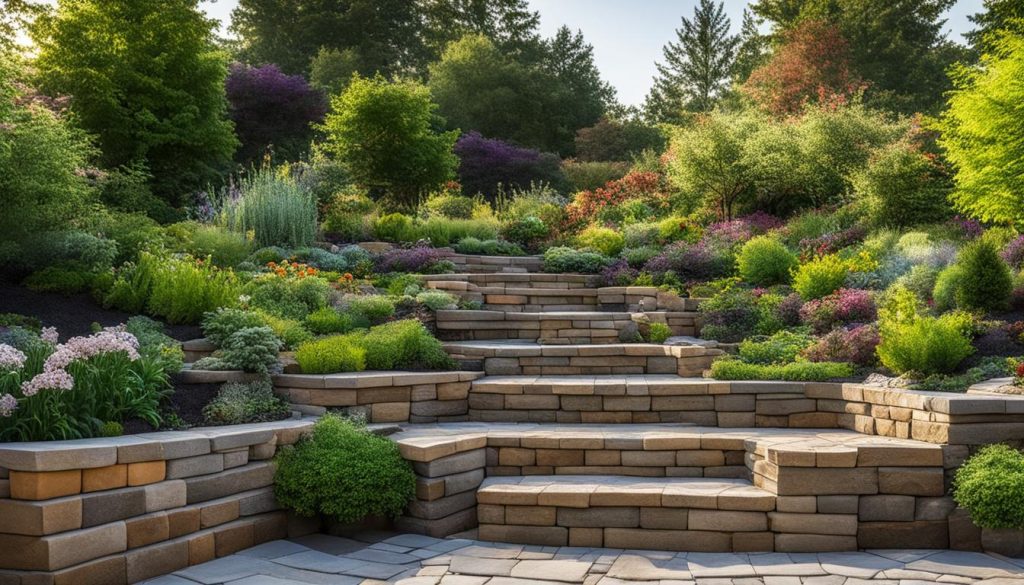Welcome to our comprehensive guide on building a retaining wall for your garden. If you’re looking to level an uneven surface, prevent soil erosion or create terraced areas, a garden retaining wall may be the perfect solution. Follow our step-by-step guide to ensure success and create a beautiful and functional addition to your outdoor space.
Key Takeaways
- Building a garden retaining wall can add functionality and beauty to your outdoor space.
- Before starting construction, assess your garden’s needs and determine the purpose of the retaining wall.
- Designing your retaining wall is crucial to ensure it complements your garden’s aesthetics.
- Proper preparation of the site and building a solid foundation are essential for the stability and longevity of your garden retaining wall.
- Regular maintenance is key to ensuring the longevity of your garden retaining wall.
Assessing Your Garden’s Needs
Before we start building your garden retaining wall, we need to assess your garden’s needs to ensure the wall is serving its purpose. Assessing the requirements of your garden will help you to plan the design and choose the appropriate materials. Here are some factors to consider:
Determine the Purpose of the Retaining Wall
The retaining wall can be used for various purposes, such as leveling an uneven surface, preventing soil erosion, or creating terraced areas. By understanding these requirements, we can design and construct the retaining wall that best suits the needs of your garden.
Consider the Aesthetics of Your Garden
The retaining wall should complement the overall aesthetic of your garden. Consider your garden’s existing features, such as its color scheme and architectural style, and design a wall that enhances its existing beauty.
Check for Local Building Codes and Regulations
Before proceeding with the construction, it’s important to check for any local building codes and regulations in your area. Certain height restrictions or materials may be required, and permits may need to be obtained. This step ensures that your project is compliant with local laws and regulations and avoids any unexpected legal issues.
Assess Soil Drainage Issues
Assessing the drainage of your garden is crucial to ensure the stability of your retaining wall. Poor drainage can cause wall failure and damage to your garden plants and landscaping. By analyzing the drainage system, we can determine if any additional drainage measures, such as the installation of drainage pipes or a gravel backfill, are necessary to prevent any future problems.
By assessing these factors, we can ensure that your garden retaining wall is both functional and visually appealing. Next, we’ll discuss the process of designing your retaining wall.
Designing Your Retaining Wall
Designing your garden retaining wall involves choosing the appropriate materials, considering its height and color, as well as ensuring it complements your garden’s aesthetics. We recommend sketching out your desired design and consulting with a professional if needed. Remember to check local building codes and obtain necessary permits before proceeding.
Choosing the Right Materials
When selecting materials for your retaining wall, consider the purpose of the wall, its design, and durability. Common materials used for retaining walls include concrete blocks, natural stone, brick, and timber. Concrete blocks are the most popular choice for their strength, durability, and flexibility in design. Natural stone, on the other hand, provides a more natural look but may be more expensive. Brick is an excellent option for smaller walls and can be easily incorporated into various designs. Timber is a versatile and cost-effective option, but it may be prone to rot and insect damage over time.
Height and Color
The height of your retaining wall will depend on its purpose, with taller walls needed for steeper slopes and deeper foundations. Consider the color of the materials used and how they will blend in with your garden’s existing color scheme. Use contrasting colors for a unique look or use natural colors for a more organic feel.
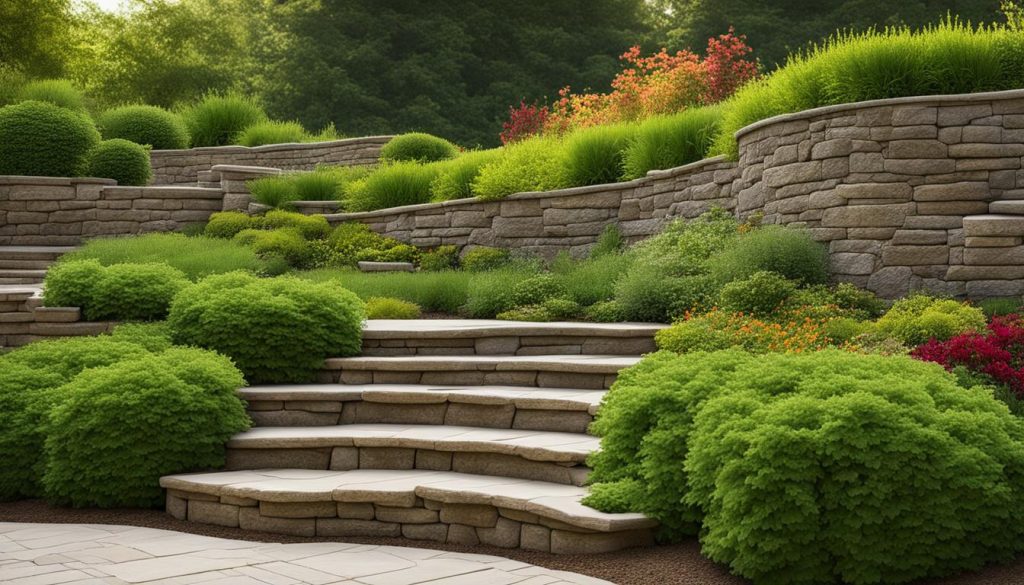
Consulting with a Professional
Consulting with a professional is an excellent way to make sure your retaining wall is properly designed. A professional can help you select appropriate materials, determine the wall’s height and design, and ensure that it complies with local building codes and regulations. You can also seek their guidance on any potential problems that may arise in the construction process.
Local Building Codes and Permits
Before starting any construction, check local building codes and regulations to ensure that your retaining wall meets all necessary standards. Make sure to obtain all necessary permits before proceeding with any construction work. Violating any local building codes and regulations may result in fines, and the wall may need to be demolished if it is not up to code.
By taking the time to properly design your retaining wall, you can ensure that it complements your garden’s aesthetics and functions appropriately. Keep in mind the height, materials, and color when designing your wall. Seek professional guidance if needed, and check local building codes and regulations before starting any construction work.
Gathering the Required Materials and Tools
Before we start building our garden retaining wall, we need to gather all the necessary materials and tools. The right equipment ensures we complete the project safely and efficiently. Here’s what we’ll need:
| Materials | Tools |
|---|---|
| Concrete blocks or stones | Shovel |
| Gravel | Level |
| Geotextile fabric | Wheelbarrow |
| Drainage pipes | Safety equipment (gloves, goggles) |
Ensure all the materials are of high quality and appropriate for your specific project. Depending on the size of the wall, you may also need a Bobcat or excavator for larger excavations. It’s important to have everything you need on hand to prevent unnecessary interruptions during the building process.
Note: For larger projects, consult a retaining wall installation expert to ensure you have all necessary materials and tools before starting. They can advise on the correct equipment needed to ensure a smooth installation process.
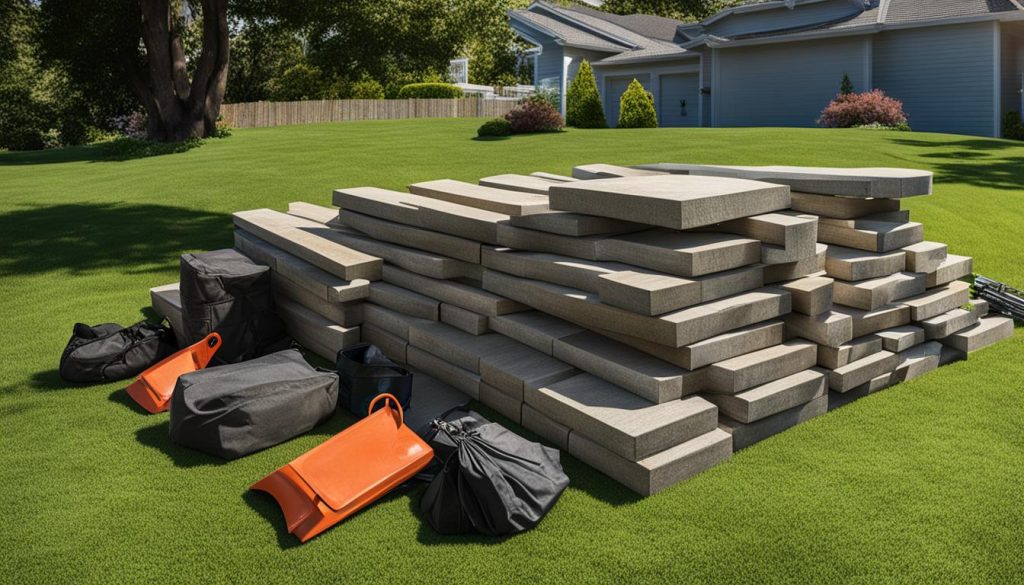
Preparing the Site
Before we begin any construction, it’s crucial to prepare the site properly. This step is vital for ensuring the stability of the retaining wall and preventing any future issues.
Clearing the Area
The first step is clearing the area of any plants, debris, or obstacles. This will allow us to easily access the site and prevent any interference during the building process.
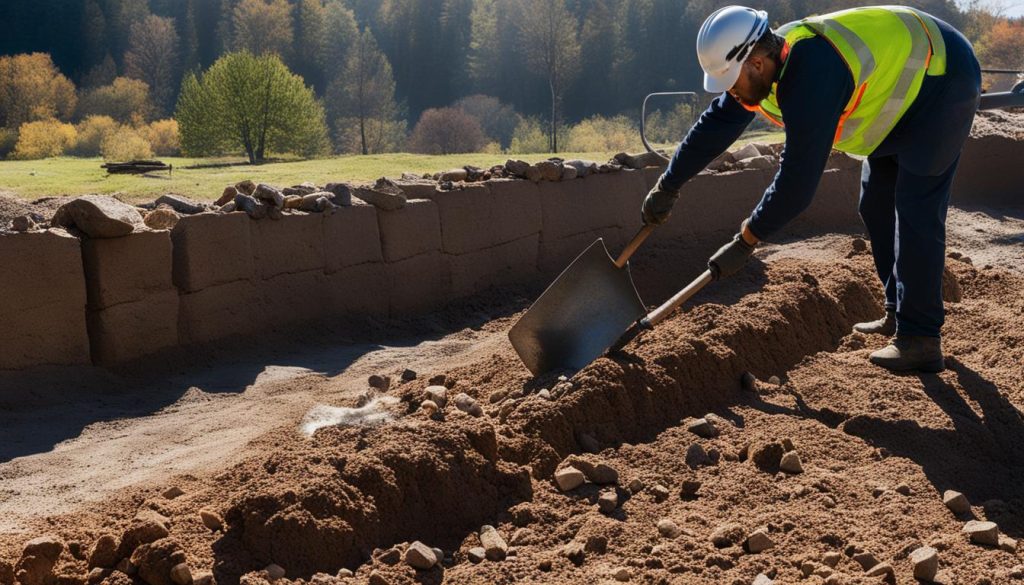
Leveling the Ground
After clearing the area, we need to ensure the ground is level. Uneven surfaces can cause instability in the retaining wall, so it’s important to level the ground as much as possible. This can be done using a shovel and a level, or for larger areas, a grading machine can be used.
Marking the Layout
Once the ground is level, mark the desired layout of the retaining wall. This can be done using stakes and string, or spray paint. Ensure the layout is accurate, as it will determine the wall’s shape and size.
Excavating the Soil
The last step in site preparation is excavating the soil to accommodate the foundation and prepare for proper drainage. The depth of the excavation will depend on the height of the retaining wall, but it’s recommended to excavate at least 6 inches deeper than the depth of the foundation.
By properly preparing the site, we can ensure the stability and longevity of the garden retaining wall. Remember to take accurate measurements and follow the design plan closely. With a solid foundation in place, we can move on to building the retaining wall.
Building the Retaining Wall Foundation
In this section, we will discuss the importance of building a strong foundation for your garden retaining wall. A proper foundation will ensure the stability of the wall and prevent it from shifting or collapsing over time.
Assessing Your Soil
Before beginning the foundation construction, it’s important to assess the soil type and stability of your garden. This will determine the type of foundation you need to build.
If your soil is prone to erosion or instability, you will need to dig deeper to create a strong foundation. It’s important to consult with a soil engineer or a professional retaining wall builder if you are unsure of your soil conditions.
Creating the Trench
Start by digging a trench along the length of the wall, ensuring it is level. The trench should be wider than the base of the wall and deep enough to accommodate the first course of blocks or stones.
Adding Gravel
Add a layer of gravel to the bottom of the trench to provide proper drainage. The gravel will also act as a stable base for the foundation blocks or stones.
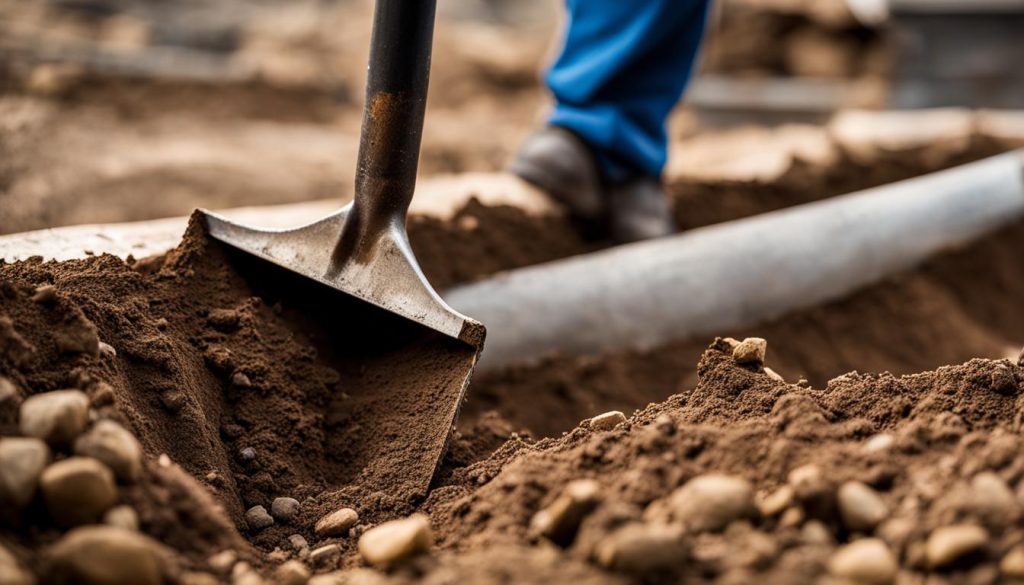
Installing Geotextile Fabric
Lay down a layer of geotextile fabric over the gravel to prevent soil erosion and improve drainage. The fabric will hold the soil in place and prevent it from seeping through the gravel layer.
Building the Foundation
With the base prepared, it’s time to start building the foundation using concrete blocks or stones. Ensure that the blocks or stones are level and securely anchored in place. Use a level to check the alignment and a tamper to compact the soil behind the blocks or stones.
In conclusion, building a strong foundation is key to achieving a sturdy and long-lasting retaining wall. Take the time to properly assess your soil and soil needs, create a stable trench, layer in gravel, and add geotextile fabric before installing the first course of blocks. By following these steps, you can ensure the stability and longevity of your garden retaining wall for years to come.
Constructing the Retaining Wall
With the foundation in place, it’s time to start constructing the retaining wall. This is a crucial step where we need to pay attention to every detail to ensure the success and longevity of the wall. Here are the steps:
- Begin by laying the first row of blocks or stones according to the desired design. Place them on a bed of mortar, with a 1/2 inch of mortar between each block or stone. Use a level to ensure that the first row is level and properly aligned.
- For the second row, apply a thin layer of mortar to the top of the first row of blocks or stones. Place the second row of blocks or stones on top, offsetting the seams between the blocks or stones in the first row.
- Repeat the previous step until the retaining wall has reached the desired height. Check that each row is level and properly aligned before proceeding to the next row.
As we build the retaining wall, we must ensure that it is sloped backward toward the soil it is retaining. This will provide additional stability and prevent the wall from bulging or collapsing under pressure.
Once the retaining wall is complete, we need to backfill behind the wall with gravel or soil, compacting as we go for added stability. It’s also important to check that drainage pipes are properly installed to prevent soil erosion and ensure proper water flow.
It’s important to note that the construction process may vary depending on the chosen materials and design. Consult with a professional if needed.
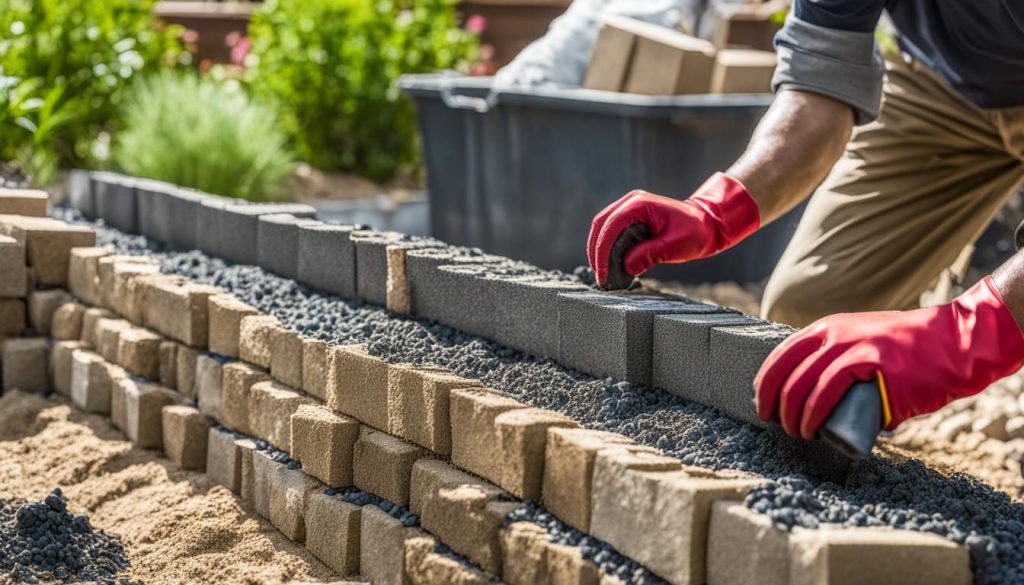
As we can see from the image, constructing a retaining wall can be physically demanding, so it’s crucial to have the necessary tools and safety equipment. Wear gloves to protect your hands and safety goggles to shield your eyes from flying debris. Keep children and pets away from the construction area to avoid accidents.
With the retaining wall built, we can move on to adding finishing touches to enhance its appearance and functionality. Check out the next section for tips on adding capstones, seating options, and more.
Adding Finishing Touches
Congratulations, you have successfully built your garden retaining wall! Now it’s time to add those final touches that will make it even more attractive and functional. Here are a few ideas to get you inspired:
Capstones and Seating
Adding capstones on top of your retaining wall not only enhances its visual appeal, but it also provides a more comfortable seating option. You can choose from a variety of materials such as concrete, brick, or natural stone and pick a color that coordinates with your garden’s design.
Consider adding seating areas around your retaining wall to create a cozy spot to sit and enjoy the scenery. You can use the capstones as benches or add garden furniture such as chairs and a table. It’s an excellent way to turn your garden retaining wall into an outdoor living area.
Plants and Lighting
One way to add color and life to your retaining wall is by planting vegetation along the wall’s base or in between the stones or blocks. Choose plants that thrive in your local climate and are low maintenance to ensure they are sustainable. This will soften the look of your wall and create a more natural environment.
To highlight your garden retaining wall in the evening, consider installing outdoor lighting. It will not only create an ambiance but also improve safety and visibility. You can choose from various lighting options, such as lanterns, string lights, or spotlights, depending on your preference and budget.
Personal Touches
Your garden retaining wall should reflect your personality and style. Consider adding personal touches such as your favorite quote or a colorful mosaic to the wall. It’s a fun and artistic way to add a unique touch to your outdoor space.
Image: Garden Retaining Wall with Capstones
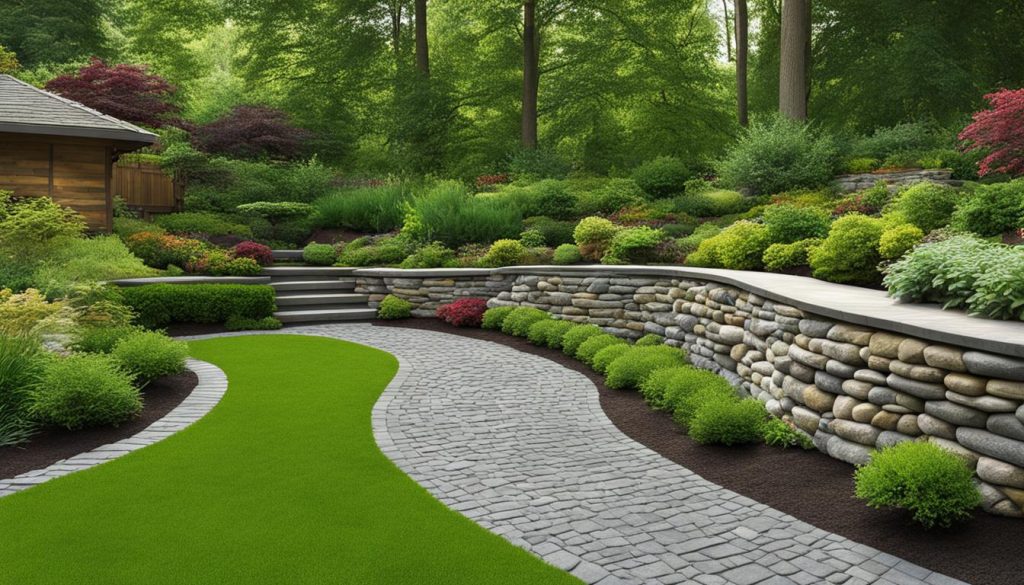
Adding these finishing touches to your garden retaining wall will not only enhance its appearance but also make it more functional. Take some time to choose the right options that match your garden’s design and personal style. We hope you enjoy your new outdoor space!
Maintaining and Repairing Your Retaining Wall
Now that your garden retaining wall is complete, it’s important to keep up with regular maintenance to ensure its longevity and functionality. Here are some tips for maintaining and repairing your retaining wall:
Regular Inspections
Perform regular inspections of your retaining wall for any signs of damage or wear and tear. Look for cracks, bulging, or any other signs of structural issues. If you notice anything unusual, address it promptly to prevent further damage.
Cleaning and Clearing
Keep your retaining wall clean and free of debris. This includes clearing any leaves or other obstructions from the drainage system to prevent water buildup and potential erosion. Use a power washer or scrub brush to remove any dirt or grime buildup on the wall.
Monitoring Erosion
Check for any signs of erosion around the foundation of your retaining wall. This can be caused by water buildup or excessive soil saturation. Address any issues promptly to prevent further erosion and potential damage to your wall.
Professional Repairs
If you notice any significant damage to your retaining wall, it’s best to contact a professional for repair services. Attempting to repair the wall on your own may result in further damage and potentially hazardous situations. Contact a reputable retaining wall repair service like Retaining Wall Repair at (647) 812-9837 for assistance.
By following these tips for maintaining and repairing your garden retaining wall, you can ensure its longevity and continue to enjoy its benefits for years to come.
FAQ
How long does it typically take to build a garden retaining wall?
The time it takes to build a garden retaining wall can vary depending on factors such as the size of the wall, experience level, and weather conditions. On average, it may take several days to a few weeks to complete the construction process.
Do I need a permit to build a retaining wall in my garden?
It is important to check with your local municipality or homeowner’s association regarding any permits or regulations for building a retaining wall. In some cases, a permit may be required, especially for taller walls or if the wall is positioned near property boundaries.
What materials can I use for my garden retaining wall?
There are various material options available for garden retaining walls, including concrete blocks, natural stones, timber, or even bricks. The choice of material will depend on factors such as personal preference, budget, and the desired aesthetic for your garden.
How do I ensure proper drainage for my retaining wall?
Proper drainage is essential for the stability of your retaining wall. During construction, you can incorporate drainage pipes or gravel behind the wall to allow water to flow freely. Additionally, using geotextile fabric can help prevent soil erosion and promote adequate drainage.
Can I build a retaining wall myself, or should I hire a professional?
It is possible to build a retaining wall yourself if you have the necessary skills and experience. However, if you have any doubts or if the project is complex, it is recommended to consult with a professional. They can provide guidance, ensure structural integrity, and help navigate any local building codes or regulations.
How do I maintain my garden retaining wall?
Regular maintenance is important to keep your retaining wall in good condition. Inspect the wall periodically for any signs of damage and address them promptly. Clear any debris or obstructions from the drainage system, and monitor erosion around the wall. If you notice significant damage or require repairs, it is advisable to contact a professional retaining wall repair service.

